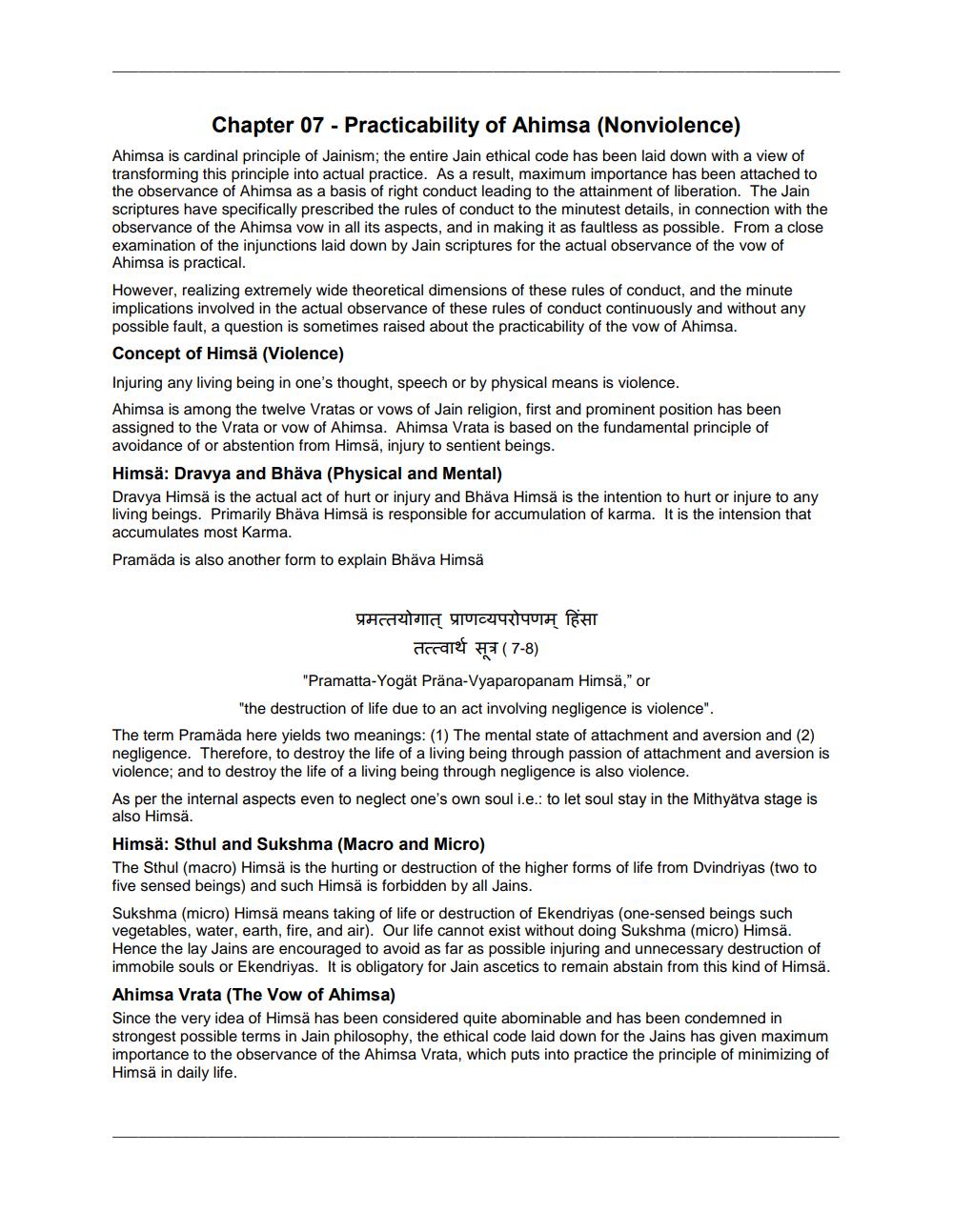________________
Chapter 07 - Practicability of Ahimsa (Nonviolence)
Ahimsa is cardinal principle of Jainism; the entire Jain ethical code has been laid down with a view of transforming this principle into actual practice. As a result, maximum importance has been attached to the observance of Ahimsa as a basis of right conduct leading to the attainment of liberation. The Jain scriptures have specifically prescribed the rules of conduct to the minutest details, in connection with the observance of the Ahimsa vow in all its aspects, and in making it as faultless as possible. From a close examination of the injunctions laid down by Jain scriptures for the actual observance of the vow of Ahimsa is practical.
However, realizing extremely wide theoretical dimensions of these rules of conduct, and the minute implications involved in the actual observance of these rules of conduct continuously and without any possible fault, a question is sometimes raised about the practicability of the vow of Ahimsa.
Concept of Himsä (Violence)
Injuring any living being in one's thought, speech or by physical means is violence.
Ahimsa is among the twelve Vratas or vows of Jain religion, first and prominent position has been assigned to the Vrata or vow of Ahimsa. Ahimsa Vrata is based on the fundamental principle of avoidance of or abstention from Himsä, injury to sentient beings.
Himsä: Dravya and Bhäva (Physical and Mental)
Dravya Himsä is the actual act of hurt or injury and Bhäva Himsä is the intention to hurt or injure to any living beings. Primarily Bhäva Himsä is responsible for accumulation of karma. It is the intension that accumulates most Karma.
Pramäda is also another form to explain Bhäva Himsä
प्रमत्तयोगात् प्राणव्यपरोपणम् हिंसा तत्त्वार्थ सूत्र (7-8)
"Pramatta-Yogät Präna-Vyaparopanam Himsä," or
"the destruction of life due to an act involving negligence is violence".
The term Pramäda here yields two meanings: (1) The mental state of attachment and aversion and (2) negligence. Therefore, to destroy the life of a living being through passion of attachment and aversion is violence; and to destroy the life of a living being through negligence is also violence.
As per the internal aspects even to neglect one's own soul i.e.: to let soul stay in the Mithyätva stage is also Himsä.
Himsä: Sthul and Sukshma (Macro and Micro)
The Sthul (macro) Himsä is the hurting or destruction of the higher forms of life from Dvindriyas (two to five sensed beings) and such Himsä is forbidden by all Jains.
Sukshma (micro) Himsä means taking of life or destruction of Ekendriyas (one-sensed beings such vegetables, water, earth, fire, and air). Our life cannot exist without doing Sukshma (micro) Himsä. Hence the lay Jains are encouraged to avoid as far as possible injuring and unnecessary destruction of immobile souls or Ekendriyas. It is obligatory for Jain ascetics to remain abstain from this kind of Himsä.
Ahimsa Vrata (The Vow of Ahimsa)
Since the very idea of Himsä has been considered quite abominable and has been condemned in strongest possible terms in Jain philosophy, the ethical code laid down for the Jains has given maximum importance to the observance of the Ahimsa Vrata, which puts into practice the principle of minimizing of Himsä in daily life.




